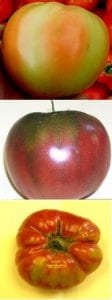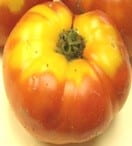Jerry Brust, IPM Vegetable Specialist, University of Maryland;jbrust@umd.edu
I have been getting emails and calls about tomato ripening problems such as blotchy ripening, yellow shoulders, grey wall, internal whitening, etc. (Figures 1, 2 and 3). They all have the same root cause; a lower level of potassium (K+) than what is needed by the fruit to ripen properly. One of the more common problems I have seen is internal whitening, this occurs when the outside of the tomato appears nice and red, but when cut open there are large areas of white blotches of hard corky tissue which are not confined to the outer wall of the fruit but are found throughout the interior walls of the fruit (Figure 2). We usually find that the soil K+ levels are adequate or even at high levels for K+, but the tissue samples are low to very low in K+ (2.5-1.5%). We also are starting to see problems in the field with yellow shoulders and uneven ripening (Figures 1 and 3). These maladies come in mid to late July when plants are putting on a heavy fruit load and temperatures and humidity are high. The cause is the same, K+ levels too low in the plant. This is often caused by roots that are concentrated in the top 6-8 inches of soil under black plastic, which can raise soil temperatures to the point where the uptake of K+ and other nutrients are reduced enough to cause ripening problems. Some things I have discussed in the past that help reduce these ripening problems include feeding more K+ through the drip, using foliar sprays to add a little more K+, using white plastic mulch instead of black for mid-season tomatoes and using a 30% shade cover over the tomatoes.
Figure1. Various forms of ripening problems for tomatoes in the Mid-Atlantic
Figure 2. Internal whitening of tomato fruit
Figure 3. Yellow shoulders in tomato



